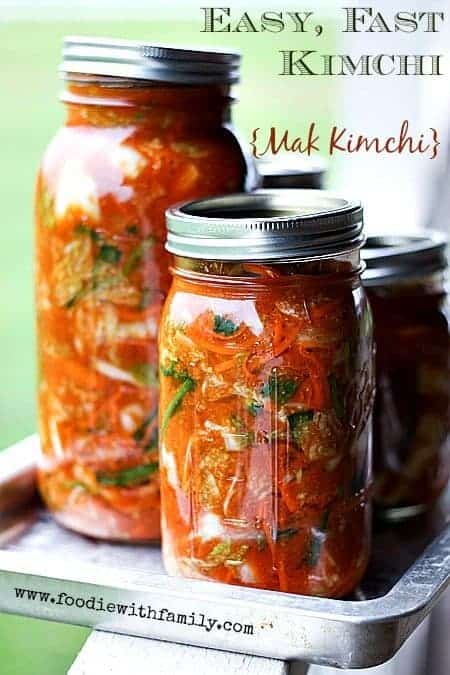
Love this Easy, Fast Mak Kimchi recipe? Check out our other fabulous Korean Food Recipes!
If you’ve been with me for a while, you’re well aware of my undying love for kimchi. Yes, it is stinky and bubbly and more than a little wild, but WOWZA the taste and the texture are so worth it.
If you’re new to the Foodie with Family family and you aren’t familiar with kimchi, I can give you a super condensed description; it’s essentially spicy, aromatic Korean sauerkraut. Today, I’m bringing you a fool-proof Easy Fast Kimchi recipe {Mak Kimchi}.
What is Kimchi?
Kimchi comes in almost as many forms as there are vegetables because nearly any vegetable can be fermented. They range from super mild smell to mega funky and mellow to melt-your-face-off spicy and there is one for every possible point in between.
The kimchi recipe that I’m sharing today is my family’s favourite version. It’s chock full of fabulous pro-biotics (as most kimchi is) and the longer it ages (translation: ferments) the stronger it becomes in both flavour AND pro-biotic content.
It’s like yogurt on steroids, people. That’s how good it is for you!
Is Kimchi Good For You?
Health Magazine named kimchi one of it’s Top 5 World’s Healthiest Foods. It is is low in calories and fat and high in dietary fiber and wicked high in Vitamins A, B, and C.
Many (if not most) Koreans eat a little kimchi with each meal or at least once a day. Kimchi is credited with helping most Koreans avoid obesity by virtue of its ability to satisfy even while being low calorie and low fat.
Seoul National University conducted a study and claimed that chickens infected with the H5N1 virus, also called avian flu, recovered after eating food containing the same cultured bacteria found in kimchi. That’s good enough for me!
How to Make Kimchi
Let’s get cracking and make some kimchi, shall we? The variety we’re making today is an Easy, Fast Kimchi recipe or Mak Kimchi…
In other words, it’s already cut up and ready to shovel into your mouth. Unlike what is usually just called ‘kimchi’ which is whole heads of napa cabbage smeared with the kimchi paste and allowed to ferment all wrapped up.
This version is FAR easier to make and far faster to be ready. Bonus, it is way easier to eat straight from the jar with a pair of chopsticks or a fork.
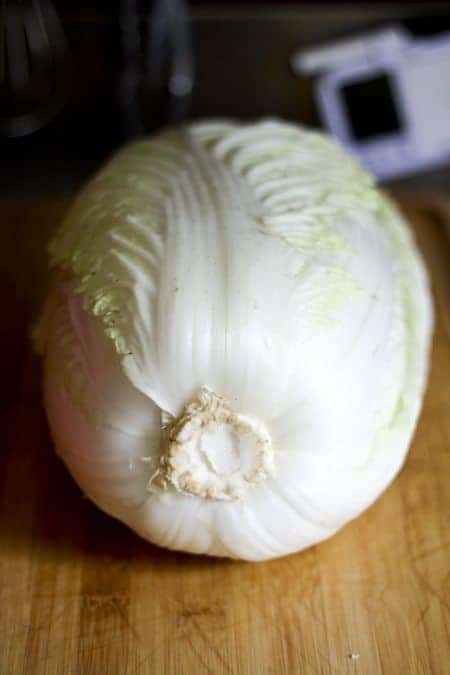
Do I need special tools to make kimchi?
In short, no. All you really need is a knife, a cutting board, and a big bowl. You will need a couple of ingredients that you may not have purchased before, but never fear, they’re not hard to find these days and I’ve included links to them below.
To begin with, you’ll need a big old head or two of Napa cabbage. I had two heads like the one above weighing in at about 3 pounds each.
It yielded, when all was said and done, about 3 quarts of kimchi, so that was perfect for me. You can cut that back if you think you can’t consume that amount of our Easy, Fast Kimchi recipe or Mak kimchi.
But I find all sorts of places to tuck it in, so it’s not an issue here and it’s only my husband, myself, and two of our boys who eat it. We love our kimchi.
Kimchi Recipe
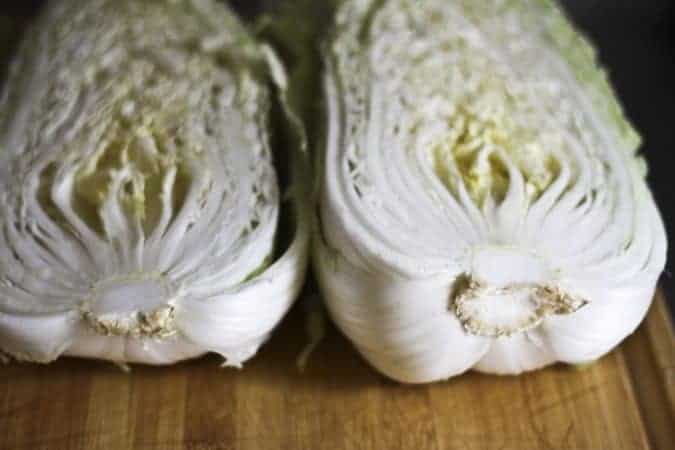
Lob your cabbages in half lengthwise. Use a paring knife to remove the gnarly core from them before cutting in half lengthwise again, leaving you with quarters.
Cut across the quarters to make bite-sized squares of cabbage. I usually shoot for 2-inch squares.
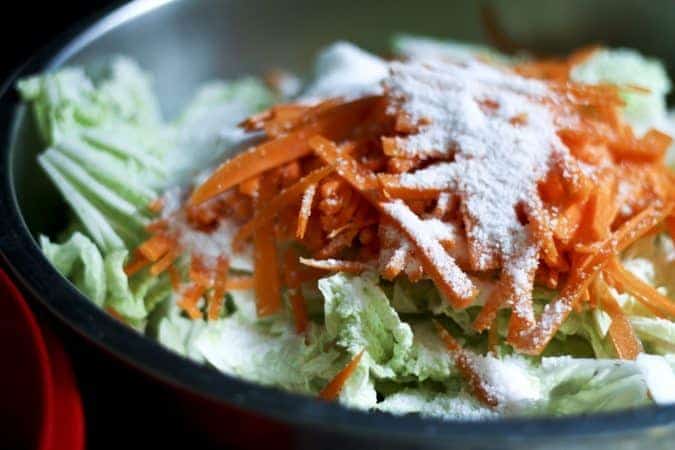
Add the cabbage to a monstrously huge bowl (or bowls), top with the julienned carrots, and sprinkle salt over the whole works. Toss the veggies and massage the mixture until the cabbage just starts to wilt.
Pour in enough cold water to over all the cabbage and carrots by a bit. It doesn’t have to be swimming in water, just covered.
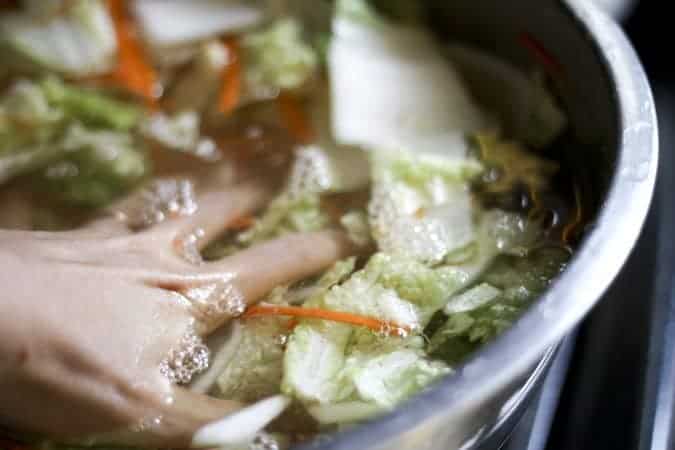
Stir it up with your hands and let it rest at room temp for a couple of hours.
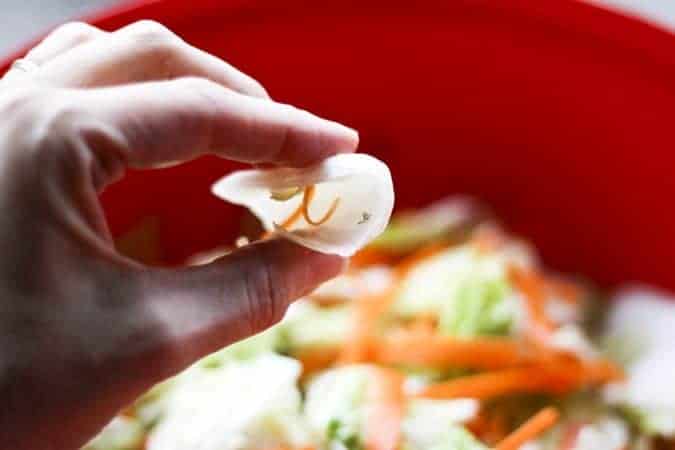
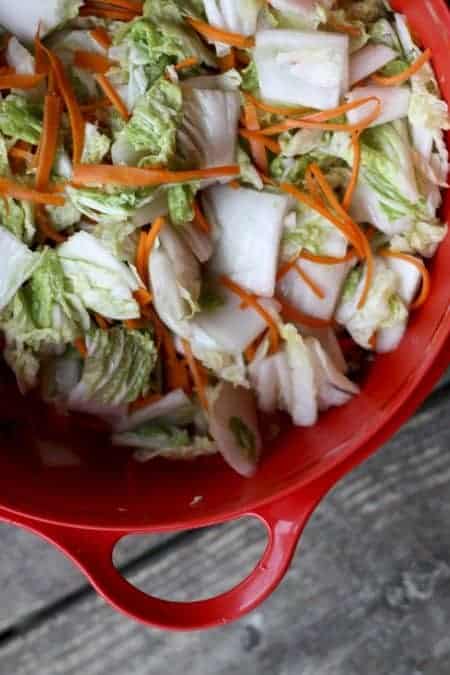
After a couple of hours, when the sturdier pieces of cabbage have become flexible, pour the whole lot into a strainer and let the brine water drain away.
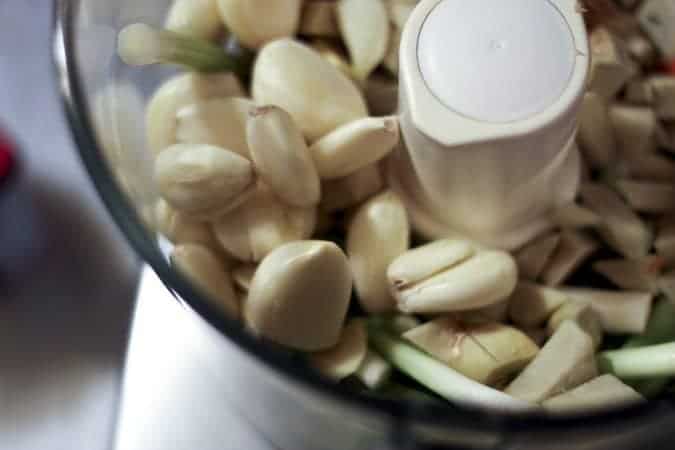
Now you’re going to whizz up the good stuff. Garlic, ginger, the white parts of scallions, Korean Red Pepper Powder*, fish sauce, unsweetened pear or apple juice, miso paste, and whatnot go into the food processor or blender.
Obliterate and smash it all into a lovely, red, fabulous smelling paste. It’s worth noting that you shouldn’t just up and increase the garlic because it can make kimchi linger more on your breath than you’d like it to do.
It also tastes out of balance if you add a lot more. Be aware.
And by the same token, you shouldn’t increase the ginger willy-nilly because that can make the final product a little more bitter than you’d like it to be. Start with the mixture and proportions I’m giving you and then play with it in subsequent batches.
*It’s important to note that you cannot use American or Mexican Chili Powder in place of the Korean pepper powder here. They’re COMPLETELY different animals. It may end up tasty, but I haven’t tested it so I cannot speak to it.
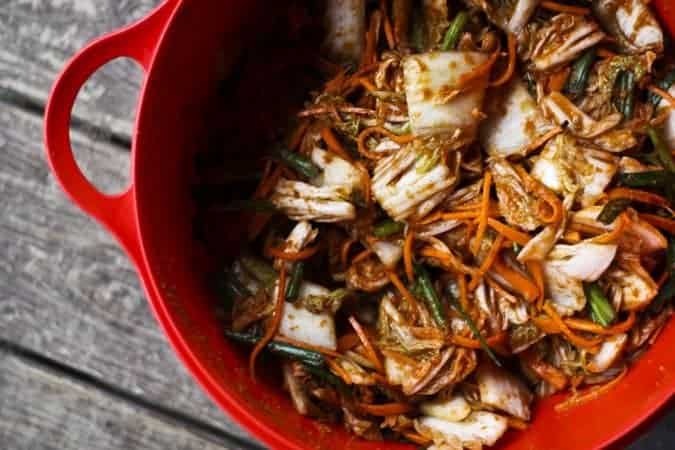
Now you’ll CRAM this stuff into jars or food-safe plastic containers. When I say cram it, I mean shove it in there as firmly as you can without putting your fist through the bottom of the jar.
I do prefer glass canning jars, if you’re wondering, because they don’t retain odors like plastic does, and, well, this stuff is odiferous! You can use a dedicated plastic kimchi bucket if you’d prefer, though.
Gently place a lid and ring on the jar, but don’t screw it tightly into place because BOOM. It’ll pop. This is active stuff, mes amies!
Place the jar on a rimmed pan or baking dish. The rim is pretty crucial here, because as the kimchi ferments at room temperature (and more slowly but still actively in the refrigerator) it will bubble up and may release a little juice over the edge of the jars.
In other words, you could have a kimchi river a-flowin’ on your counter top unless you take precautions. It’s easiest to use the pan and not worry about your Easy, Fast Kimchi recipe or Mak Kimchi bubbling over onto your counters.
It’s going to spend a couple of days at room temperature getting bubbly and fragrant. Every day, you’ll insert a clean chopstick or butter knife into the jar to help release air bubbles and top the jar off with extra brine if needed to keep everything submerged.
When it’s almost carbonated looking (usually between 24-72 hours after packing the jars), it’s ready to refrigerate. I highly recommend refrigerating it on the tray you used to contain the Grand Kimchi River while it fermented.
There aren’t a lot of things quite as unnecessary as removing everything from a fridge and mopping kimchi juices off of it. Take my word for it.
How long can I keep homemade kimchi?
It’s ready to eat at that point! Of course, it gets stronger and more kimchi-y the longer it sits. I love cooking with the older stuff and eating the newer stuff ‘raw’.
One of my all-time best-loved ways to eat older kimchi is in pancake form. Not like Aunt Jemima pancakes or flapjacks, but savoury, crispy-edged, kimchi-studded, pan-fried, snack cakes that convert even die-hard kimchi skeptics.
It’s the only way my eldest likes kimchi, but OH how he loves it this way. And the smell of kimchi pancakes while they cook is irresistible.
Bonus: This stuff lasts just about forever when you make sure the veggies are submerged in the brine. It’s hard to go wrong.
What can I make with my kimchi recipe? How do I use kimchi?
-Kimchi Fried Rice AND another version of Kimchi Fried Rice (the second one has a fried egg on top. SWOON!)
-Korean Army Stew- Budae Jjigae
-Kimchijeon (Savoury Kimchi Pancake)
Kimchi Ingredients
Kimchi
Cut the napa cabbage in half longways, then in half again longways. Cut the core out of the four quarters.
Cut the cabbage into squares (about 2-3 inches square), pop it in a bowl with the carrots. Sprinkle with the 1/2 cup kosher salt, massage so everything is coated in salt and starting to soften and wilt. Fill with cold, chlorine free water to cover it well and let it soak for at least 1 1/2 hours.
Pour the cabbage and carrots and liquid into a strainer. Let the brine drain away.
Lob off the white bits of the green onions and put them in a food processor with the garlic cloves, ginger, miso paste, and korean pepper powder. Zap it on high ’til it’s smooth-ish. Add in the fish sauce and a couple of slops of pear juice and zap it more until it’s about pancake batter consistency… maybe a bit thinner.
Put the brined cabbabe/carrots in a big, anti-reactive (glass, enamel, or stainless steel) bowl. Rough chop the green parts of the onions and add those to the cabbage/carrots. Pour the chili paste combo over the cabbage and wear gloves to massage it all over the cabbage/carrots green onions so everything is completely covered.
Pack super tight in canning jars. CRAM it in there.
Add a two-piece lid, but just set the ring in place to hold the lid down without screwing it in place. Place it on a rimmed baking dish to catch any spill-over.
Let it sit at room temperature for up to 72 hours, until it is bubbly and fragrant. Once every day, insert a clean chopstick or butter-knife to release air bubbles. If needed, pour in some additional brine to keep all the vegetables submerged.
Store on a rimmed sheet in the refrigerator for up to six months, being sure that the vegetables are submerged the whole time. The older it gets, the stronger it will become.
Notes
If you need extra brine to keep your vegetables submerged, please combine 1 quart of cool water with 4 teaspoons of kosher salt in a quart jar with a tight fitting lid and shake until the salt is dissolved. Use it to top off the vegetables as needed.
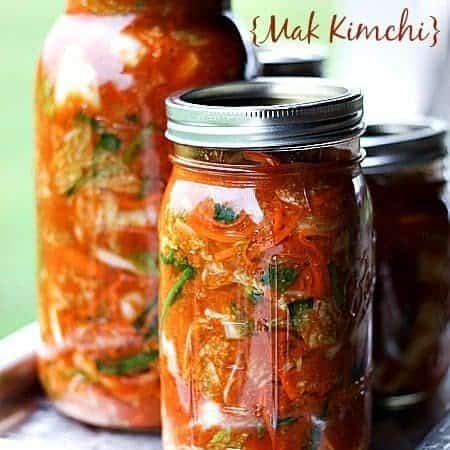
Easy, Fast Kimchi Recipe {Mak Kimchi}
Rate RecipeIngredients
- 3-8 pounds napa cabbage
- 2 bunches green onions trimmed of the root bits
- 2-3 large carrots peeled, thinly julienned
- 1/2 cup kosher salt
- 1/2 cup korean chili powder
- 15-20 cloves garlic overdoing garlic makes this stay on your breath more than usual., peeled
- 4-6 inches ginger peeled, rough chopped
- 1 tablespoon fish sauce
- unsweetened pear juice or unsweetened apple juice
- 4 tablespoons white miso paste
Instructions
- Cut the napa cabbage in half longways, then in half again longways. Cut the core out of the four quarters. Cut the cabbage into squares (about 2-3 inches square), pop it in a bowl with the carrots. Sprinkle with the 1/2 cup kosher salt, massage so everything is coated in salt and starting to soften and wilt. Fill with cold, chlorine free water to cover it well and let it soak for at least 1 1/2 hours.
- Pour the cabbage and carrots and liquid into a strainer. Let the brine drain away.
- Lob off the white bits of the green onions and put them in a food processor with the garlic cloves, ginger, miso paste, and korean pepper powder. Zap it on high ’til it’s smooth-ish. Add in the fish sauce and a couple of slops of pear juice and zap it more until it’s about pancake batter consistency… maybe a bit thinner.
- Put the brined cabbabe/carrots in a big, anti-reactive (glass, enamel, or stainless steel) bowl. Rough chop the green parts of the onions and add those to the cabbage/carrots. Pour the chili paste combo over the cabbage and wear gloves to massage it all over the cabbage/carrots green onions so everything is completely covered.
- Pack super tight in canning jars. CRAM it in there. Add a two-piece lid, but just set the ring in place to hold the lid down without screwing it in place. Place it on a rimmed baking dish to catch any spill-over. Let it sit at room temperature for up to 72 hours, until it is bubbly and fragrant. Once every day, insert a clean chopstick or butterknife to release air bubbles. If needed, pour in some additional brine to keep all the vegetables submerged.
- Store on a rimmed sheet in the refrigerator for up to six months, being sure that the vegetables are submerged the whole time. The older it gets, the stronger it will become.
Notes
Nutrition
Nutritional information is an estimate and provided to you as a courtesy. You should calculate the nutritional information with the actual ingredients used in your recipe using your preferred nutrition calculator.
did you make this recipe?
Make sure to tag @foodiewithfam on Instagram and #hashtag it #foodiewithfamily so I can check it out!
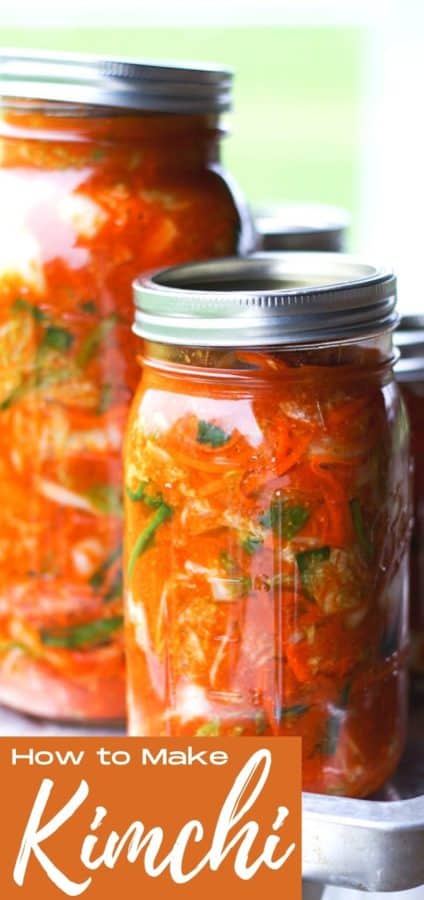
This post was originally published on December 2, 2013 and was updated December 28, 2016, June 2018, and September 2021.
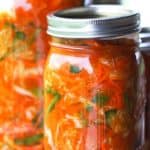



Reader's Thoughts...
Jeannie says
im not able to find Miso paste…is this a necessary ingredient? Is there s substitute?
Rebecca says
It isn’t strictly necessary, but I find it kick starts the fermentation nicely because it is a fermented product itself!
Jeanette Mitchell says
Wegmans, whole foods
Rebecca says
Fellow Wegman’s fan here!!!!
Linda says
Thank you for your recipe I have made it several times and love the stuff. I put dakon radish in once just for the heck of it but it isn’t needed.
Carmen aka keenpetite says
Late husband served 3 yrs in Korea, loved authentic asian food including kimchi, I enjoy it but milder
great recipe to try soon & truly enjoy.Have glass jars ready use.
Chicken, shrimp & more.
Carrmen aka keenpetite
V.Stoen says
I absolutely love kimchi ! Right now I have 1 1/2 gallons in my frig . I eat it every day, just can’t go without it . I crave ,crave crave it ! Your recipe is somewhat similar to the recipe I use given to me by my Korean friend of many years . When I make it I go with about 18lbs.of napa cabbage ( yes a lot ) I’am addicted to kimchi ! The time for letting the cabbage rest with kosher salt is the same but I turn the cabbage every 30 minutes , 3 times . I never add H2O while cabbage is resting only because she said you never add H2O . After 1 1/2 hours I rinse 3 times . I do use a lot more fish sauce thought 1 1/2 cups which as you know is salty but is with about 18 lbs of cabbage.. I guess if I were not to rinse I wouldn’t use that amount of fish sauce. Also I use daikon radish ,dried shrimp and grated asian pear . I was going to make cucumber kimchi but my cucs didn’t do well this year . I’am for sure going to try your kimchi recipe as soon as we get through what’s in the frig . Oh …..kimchi is great on a pizza with a strong cheese like asiago,maybe because cheese is fermented as well ,they really compliment each other. Thank you for having such a colorful and great blog to explore !
Dancing kitchen says
That funky kimchi river, collected and mixed with mayo makes a glorious kimchi aioli. I mix it with precut slaw mix for an awesome kimchi slaw. I crave kimchi and eggs, my favorite breakfast. I also add it to sushi bombs, nori cut into 1/4 sheets and filled by the individual with rice, lightly cooked kimchi, cooked egg, corned beef, smoked salmon, anything you would roll into sushi. Dip into wasabi soy or just pop into your mouth after gathering the corners. Make sure your nori is fresh.
firsttimer says
I noticed you didn’t say anything about rinsing the cabbage before mixing it with the sauce. Most recipes say you should rinse it. Mine fermented fine, but seemed pretty salty. Did you leave that step out?
Rebecca says
Truth… I didn’t rinse because I like mine a bit salty… Also, though, the kind and size of the grind of salt you use will effect the overall saltiness in the end product. If you’d prefer to, you can certainly rinse it!
Cindy Stewart says
i am so happy i found your page!! i love kimchi and have only made it once oh so long ago and the last few times i purchased it at a store (grocery) it was very bitter. thank you so much for sharing and to all that added the other info!! looks and sounds delish!! i posted these recipes for kimchi and others with kimchi (burger, fried cake) on g+ pin and fb! so excited! 🙂
Cindy Stewart says
oh and thanks so much for the detailed instructions too….it is very helpful! and the pics are great!
tintar says
thank you so much for this recipe!!! it’s also quite versatile you can use just about any veg –
so far, I’ve made it 3 times – first napa cabbage + carrot, next radish (both red & white) + leek, and just today bean sprouts + baby cucumber.
the red pepper linked from amazon was perfect, thank you, it really makes it taste like kimchi from a restaurant or store. also used a ~2lb white miso package from amazon.
the first 2 batches were a couple months ago – each one was about 5lb veg total and each filled about 6 pint jars. I was initially worried to have 12 pints of kimchi but between friends wanting some and the fact it is delicious over plain rice, it disappeared in a real hurry.
today I used 4lb baby cucumber and ~1lb bean sprouts. also 3 bunches of scallions (whites into the pepper paste, greens rough chopped in later – as per recipe) and 3 small cipollini onions (also into the pepper paste) from the discount table just for fun.
oh!
the first batch, the cabbage+carrot, I could not find unsweetened pear juice for the life of me. disgrace of a supermarket. so, clever me, I got a can of pears in unsweetened juice and chucked the whole thing into the pepper paste.
the 2nd batch, the radish+leek, I had gotten a couple very ripe pineapples from the discount table. 1 pineapple went into the pepper paste and people will still not stop raving about it. I am now completely out of the original 12 pints of kimchi – what was I worrying about?!
the 3rd/current batch, I had chopped up that other pineapple from months ago and frozen it – you’re darn right it went into the cucumber+sprouts batch today.
also also, whether it is cabbage or radishes or cucumbers that have been sitting in the salt water – apparently there is a Rule? – rinse 3 times after salt.
Rebecca says
You are a kimchi making master now! That’s an amazing sounding bunch of batches!!
tintar says
we live in an area Slightly Outside America, and we can’t get things like kimchi in the stores here (good thing the mighty spamazon delivers, and serves gochugaru and miso and fish sauce and kelp)
so thank you again for the recipe you can’t even imagine.
Amanda Usen says
I am so excited to try this recipe! I got my red pepper powder at the Korean food store today! Thank you!
Julia says
My mom gave me a recipe for quick kimchi that’s similar to your recipe. Instead of juice, I process/blend 1/2 a fuji apple and a 1/4 red bell pepper. I’m definitely going to try yours though (sadly .. sans the fish sauce because my husband is kind of ridiculous about anything smelling fishy and he makes faces .. heh).
Patty says
GhanaGirl here ~ always asking about substitutes 🙁
I’ve been waiting for this recipe ever since you mentioned it, and was so excited to see it here today! I can order some of the odder ingredients, but I cannot order napa cabbage. Would this work with regular cabbage? Here’s to hoping!
Patty
Rebecca says
I have never tried it with regular green cabbage, Patty. I think it’d be worth giving it a shot. Obviously, the finished texture and flavour will be slightly different since Napa is a much more delicate cabbage to begin with, but I’d give it a try!
Eleankr says
I have tried eating thegreen cabbage kimchi i/s just the same but the green cabbage is crispier
Nick says
I’ve just made some with Pak Choi and white wine vinegar. Hoping for the best
Beverly says
There is a video on youtube called emergency kimchi… She used regular green cabbage in it.. <3
Gillie says
I make a lot of cheese and have heard that whey is good in kimchi too. Would I substitute that for the fruit juice?
Rebecca says
I’ve never made whey based kimchi, so I’m not sure what you’d substitute… The fruit juice lends a little sweetness, so I might be leary of eliminating that!
Danielle says
Here’s my Korean two cents. 🙂
I believe it’s “Mak” Kimchi. That’s how it’s spelled in Korean. It can be confusing because, with the way the syllables are put together, they can sound very similar. “Mat (mott)” means “taste” in Korean. “Mak” has to do with the process of making it quick and sort of modified. It’s the “casual” kimchi, if you will. The “proper” Kimchi is to make it with whole cabbage, split lengthwise and stuffed with fillings and seasonings, which by the way tastes better because it does not get exposed to air until you slice it right before serving. It also presents better. 🙂 But mahk-kimchi is easier to serve. Oh, and the slower it ferments, the better it is. Traditionally, the fall batch of kimchi is kept in pots outside through the winter, buried underground except for the lid, to keep it insulated. It’s rare to find people doing it that way anymore, but I still remember the taste of kimchi that’s slowly fermented that way.
I’m surprised to see miso paste as an ingredient! It is non-traditional, but your kimchi looks very yummy! And I’m so impressed you make it! I’m Korean and I don’t make it at home anymore.
jeri says
In NYC we have many varieties of locally made kimchi. We put it on everything: rice, baked potatoes, grilled meat and fish, scrambled eggs. sandwiches, even hot dogs in place of sauerkraut. There’s a little bahn mi sandwich shop in my neighborhood that puts it on French fries with some kind of secret sauce. Weird, but totally addicting.
Terresa says
Is there any point at which you can go ahead and seal the jars? I can see them getting knocked over in the fridge and spilling out all over my rimmed pan. I’m the only one in my house that eats kimchi so three jars would last me quite a long time!
Rebecca says
You can screw the lids on a bit tighter once it goes into the refrigerator, but there’s no point at which I’d advise sealing it wicked tight.
Michelle says
You could also not fill your container all the way to the top to avoid spillage…just a thought…
Amy Kim (@kimchi_mom) says
Interesting…as Rebecca said it is a regional issue. In Seoul, “mak kimchi” is referred to as “mat kimchi” or 맛김치. Almost everywhere else in Korea, it is referred to as “mak kimchi” or 막김치. So “mat” or “mak”…it is the same thing.
However, Korea has recently been importing kimchi from Taiwan and China (which i can’t believe) and “the authorities” decided that all imported kimchi will be called “mat kimchi” / 맛김치.
(Thank to my mom for the info…I can’t take credit for it!)
Rebecca says
Go Amy’s Mom! That is so fascinating. Importing kimchi? What kind of crazy is that?
Amy Kim (@kimchi_mom) says
Yeah…isn’t it crazy?!
Jeng says
I don’t have korean chili powder but have regular and extra hot Indian chili powder is that alright
Rebecca says
Hi Jeng, I don’t actually know what extra hot Indian chili powder tastes like. I am going to guess that it’s different enough to warrant ordering the gochujang!
Marcel says
Gochujang is a paste; you were referring to gochugaru, the powder…
Rebecca says
Yes, for sure! That’ll teach me to multi-task while responding to comments. HAHA. You’re right. I meant gochugaru. 🙂
William Barnes says
Question? Is Korean chilli powder hot do I ad more to make it hotter or do I ad different peppers to make it hot kimchi. Thanks
Rebecca says
Hi William- I’d just up that chili powder content! You could also try to find a Korean chili powder that advertises itself as hotter! Feel free to add in a few hotter peppers on your own, just don’t upset the balance too much.
mo says
Oh, ok. Thanks. So, it will ferment ok without fish sauce?
The fish sauce kind of scares me fermenting. I think I want to try it without first if possible.
Rebecca says
The miso will help it ferment… but I do highly recommend the fish sauce! It doesn’t really make it ‘fishy’… it just adds that certain somethingsomething!
Rich Weston says
I believe that certain something is called umami. It used to be thought that we had 4 tastes, sweet, sour, bitter and salty. I think around 1985 a 5th taste was added, umami aka savory)
Steph says
Can i use dark miso paste instead?
Rebecca says
Hi Steph- I haven’t made it with dark miso paste, but dark miso paste tends to be saltier and more assertive in flavour. If you decide to use it, I’d reduce it by 3/4, likely.
mo says
Nice post.
You mention fish sauce in the blog but I am not seeing it in the ingredient list in the recipe. Am I crazy and can’t see it?
Rebecca says
You’re not crazy, Mo… I accidentally left it out. The recipe has been fixed and the fish sauce appears where it should! (It wouldn’t be a disaster to leave it out, and would make the kimchi vegan, but I prefer it with the fish sauce!)
Amber says
Can i also use soy sauce? I used this recipe that needed rice, soy sauce, sugar and ginger and garlic plus the powder and thats it, rather mild taste, you think it still works?
LJ says
Yes
Lukas TS says
Great recipe, easy to follow & allows for personal creativity! I probably had too much salt at first , so after adding more veggies (sliced radishes & chopped cabbage) enjoyed the reduced saltiness and varying degrees of crunchiness!
Have polished off half of the three quart batch in two weeks!
Thanks for adding to my repertoire!
Lukas
Rebecca says
Thanks for letting me know, Lukas! That sounds delicious!!!
Kathleen says
I’ve only had the “mat” version, but apparently there is also a “mak” version as well (they don’t sell the “mak” version at my store, hence the confusion). The version that I get is also sliced but doesn’t have carrots in it. So, now I’m curious too. I speak Korean, but am not a native and only lived over there for a couple years. Maybe your sister-in-law can let us know the difference! 🙂 In the meantime, I’m looking forward to trying this recipe!
Rebecca says
I have a feeling this may be a regional translation thing! We need to get some folks who know better than us to chime in, methinks! Whatever it’s called, though, it’s darned good… I hope you make some!
Davey says
I think the difference is simply trying to find an English way to spell the sound that Koreans make. I’ve always spelled this dish as kimchi, but I have a Korean friend who spells it gimchi, with a G. The actual sound is somewhere between a K and a G so there isn’t one right answer.
Kathleen says
This looks wonderful! I eat a lot of kimchi, so will definitely have to try this out as it gets expensive to buy it all the time. Also, just an fyi, it’s actually “mat” not “mak”. 🙂
Rebecca says
I hope you enjoy this version, whichever you decide to call it. 😀
Can you explain the difference between ‘mat’ and ‘mak’ to me? Because my Korean sister-in-law referred to this as Mak kimchi… and the variety that is much like this that I buy at the Korean market is labeled Mak Kimchi as well.